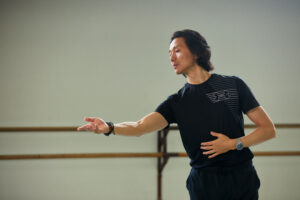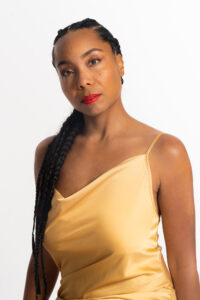
It isn’t every day one steps to the front of a classroom and gazes out at endless rows of dancers pursuing their next level of training. Being asked to teach convention-style master classes is an honor, but it can also be a daunting trial of a teacher’s skill. Little beyond hands-on experience can prepare one to manage so many dancers learning and moving in the same space.
Dance Teacher recently spoke with several esteemed educators who regularly teach large-scale master classes. Read on to learn how they manage numerous students of different skill levels at the same time, how they offer corrections to large groups, and much more.
Who’s Who
Sidra Bell: Contemporary dance educator and choreographer specializing in improvisation and composition; artistic director of Sidra Bell Dance NY; mentor and guest lecturer
Joshua Bergasse: Broadway and television choreographer; teacher at Broadway Dance Center, Steps on Broadway, and multiple conventions and universities
Runqiao Du: Classical ballet educator; artistic director of Runqiao Du Ballet Coaching

Getting Started in Teaching
Bell: “While I began around 15 years old as part in the First Steps program as an assistant in exchange for my scholarship at The Ailey School, much of my early teaching was during my undergraduate studies at Yale, through the adult programs and in the New Haven community for children. I did a lot of outreach at public schools and worked with at-risk communities.”
Bergasse: “I started teaching very young. I grew up at my mother’s dance school and taught jazz, tap, and hip hop. It wasn’t until I moved to New York in 1997 that I started teaching musical theater, in 1998.”
Du: “At the peak of my performance career with The Washington Ballet, a friend needed a teacher for a weekly adult ballet class. Exhausted at the end of my rehearsal day, I would drive there to teach.”
Managing the Big Ones
Bell: “Sometimes, I have 50 people in one class. Working frontally isn’t always best for larger scenarios, so I work circularly. The semblance of a circle allows everybody to access the material. If they can’t see me, there is always somebody next to them.”
Bergasse: “I’ve probably taught up to 300 students at special convention classes. I give class like I would want to take it. I keep the dancers moving, so I try to keep talk specific and precise. You have to constantly feed energy into the students to make sure they stay engaged. Keeping that engagement is important.”
Du: “One of the biggest classes I taught had about 60 students auditioning for scholarships at a festival. Organization was the most important element. I wanted everybody on the same page. So, I split the dancers into groups and put one student in charge of each group. Instead of teaching 60 individuals, I was teaching fewer at a time and now had teacher’s assistants to help, as well.”

Energy Is Everything
Bell: “There is something about dissolving into a group that is fun. Energetically, that many people become like a chorus. There’s a different amount of heat. It feels very communal.”
Bergasse: “If there is an energy in the room, it is infectious. The coolest thing about these classes is that dancers are being exposed to peers they normally wouldn’t dance beside. Watching the dancer next to you absorb material in a different way is almost more valuable than what the teacher is doing.”
Du: “If you can get all of the dancers in a classroom energized, the energy is phenomenal. But if you lose it, that is a lot of students to feel silence from. You need to get the dancers excited and offer a sense of belonging to this unique community.”
Giving Corrections
Bell: “I don’t give a lot of corrections. I give larger images or ideas; they are not pointed. I may ask if there is a question around the mechanics of the phrase, but they are more embodied performance notes.”
Bergasse: “I offer general corrections and engage with specific students. It is impossible to reach everyone in a class of 200. But I also don’t pick only a handful of students to pay attention to. I engage with any student who shows they are worth it.”
Du: “Walking into a new setting and not knowing the dancers’ skill set can be difficult. I can now quickly identify dancers’ skill levels, which has helped me give appropriate classes where students can learn. It is important that material is not too far out of reach. Corrections have to be in touch with where the dancers are in that moment.”
Recruiting From Class
Bergasse: “I’m never purposely looking for dancers in these classes, but sometimes I find somebody with potential and invite them into a rehearsal process. I’ve never given a job from a master class, though. If a dancer really sticks out and I have an opportunity they might be right for, I may invite them to participate.”
Du: “While rare, I only recruit from my own personal convention, DuCon. I have to be really sure a student will benefit from my teaching. Then, I’ll follow up with their parents. I’m a parent, myself. I would rather a teacher contact me directly about a scholarship, instead of talking to my daughter.”

Advice for Students
Bell: “Large classes can feel anonymous and like you aren’t getting an intimate interaction. But this is good practice in how to create your own sense of agency. How do you develop your own connection to the material without feeling like you’re courting the teacher? It is more challenging, so you have to create your own systems to manage the material. While not always ideal, it is a realistic scenario.”
On Feeling Qualified as a Master Teacher
Bergasse: “I still don’t feel qualified to teach master classes. I am always trying to be better. I think, What do they need from me? How can I help? I’m always trying to be the best teacher for students right then at that point in their training.”
Is Bigger Better?
Du: “I see a benefit for environments both big and small. If I have a class with 15 students, I can really coach and dig into something profound. But I don’t mind teaching larger classes, too. There is a beauty that allows dancers to feel a different sense of community, as long as you bring everybody on board.”
Tips & Tricks
Bergasse: “One of the hardest things to learn is time management. You may think you have a ton of time and realize they haven’t really danced. I want students to dance a lot, so I back-time it. How long is my combination? How many groups will I need? How many times do I want them to dance the combination?”
Bell: “Patience is everything in any environment. One of the best pieces of advice I got early on was to lean in to what is happening. Sometimes, you come in with a class plan, but there is something else going on. Who is in front of me creates the class.”





